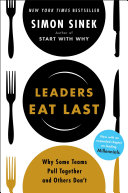

In 'Leaders Eat Last', Simon Sinek introduces the concept of the Circle of Safety, which is a metaphorical space where leaders create an environment of trust and security for their teams. This Circle encompasses all members of an organization, protecting them from external threats and internal competition. When leaders prioritize the well-being of their team, they foster loyalty and collaboration, leading to higher productivity and morale. The Circle of Safety is essential for creating a culture where employees feel valued and safe, which in turn drives innovation and success. Sinek emphasizes that when people feel secure, they are more willing to take risks and contribute creatively, as they are not preoccupied with fear or insecurity. This idea encourages leaders to look beyond mere profit and productivity metrics and focus on the human elements of their organizations.
Continue readingTrust is a foundational element in effective leadership, according to Sinek. He argues that leaders must cultivate an atmosphere of trust within their organizations to inspire loyalty and commitment among their employees. When employees trust their leaders, they are more likely to engage fully in their work and collaborate with their colleagues. Sinek illustrates how organizations that prioritize trust tend to outperform their competitors, as trust fosters open communication and a willingness to share ideas. This idea also extends to the importance of leaders being transparent and honest with their teams. By modeling trustworthiness, leaders can create a ripple effect that encourages employees to act similarly, thereby strengthening the overall culture of the organization.
Continue readingSinek delves into the biological underpinnings of human behavior, explaining how our evolutionary history shapes our responses to leadership. He discusses the roles of various chemicals in our bodies, such as cortisol, oxytocin, and serotonin, and how they influence our feelings of safety, connection, and happiness. For instance, cortisol is released during stressful situations, while oxytocin fosters feelings of trust and bonding. Understanding these biological drivers can help leaders create environments that promote well-being and collaboration. By recognizing the impact of stress and the importance of social connections, leaders can implement practices that reduce anxiety and enhance teamwork, ultimately improving organizational performance.
Continue readingSinek emphasizes that true leadership involves a willingness to sacrifice personal gain for the benefit of the team. He argues that leaders who prioritize their team’s needs over their own foster a culture of loyalty and commitment. This idea is exemplified by the military principle of 'leaders eat last,' where leaders ensure their team is taken care of before attending to their own needs. Such selflessness inspires trust and respect among team members, creating a strong bond that enhances collaboration and performance. Sinek illustrates this concept with examples from various organizations, showing that when leaders demonstrate genuine care for their employees, it leads to a more engaged and motivated workforce.
Continue readingSinek warns against the pitfalls of short-term thinking in leadership. He argues that leaders who focus solely on immediate results often overlook the long-term health of their organizations. This myopic view can lead to decisions that may yield quick profits but ultimately harm the company’s culture and sustainability. Sinek encourages leaders to adopt a long-term perspective, considering the impact of their decisions on employee well-being and organizational health. By fostering a culture that values long-term success over short-term gains, leaders can build resilient organizations that thrive in the face of challenges and change.
Continue readingIn 'Leaders Eat Last', Sinek explores the importance of creating a culture of belonging within organizations. He argues that when employees feel they belong, they are more engaged, motivated, and productive. This sense of belonging is cultivated through inclusive practices, open communication, and a shared sense of purpose. Sinek highlights that leaders play a crucial role in fostering this culture by actively promoting diversity and inclusion and ensuring that every team member feels valued. By creating an environment where everyone feels they belong, organizations can tap into the full potential of their workforce, driving innovation and success.
Continue readingSinek concludes by discussing the broader implications of leadership on society as a whole. He posits that the principles of effective leadership extend beyond individual organizations and can influence societal structures. Leaders who prioritize the well-being of their teams contribute to healthier communities and economies. Sinek argues that by embracing a leadership style that focuses on empathy, trust, and long-term thinking, leaders can create positive change not only within their organizations but also in the world at large. He calls on leaders to recognize their responsibility to foster environments that promote well-being and collaboration, ultimately leading to a more humane and sustainable society.
Continue reading